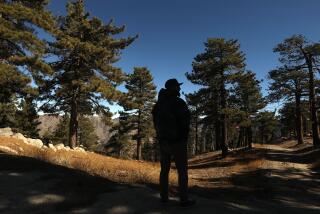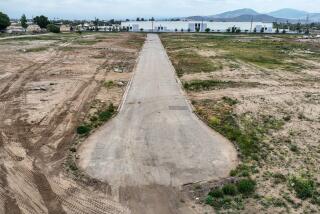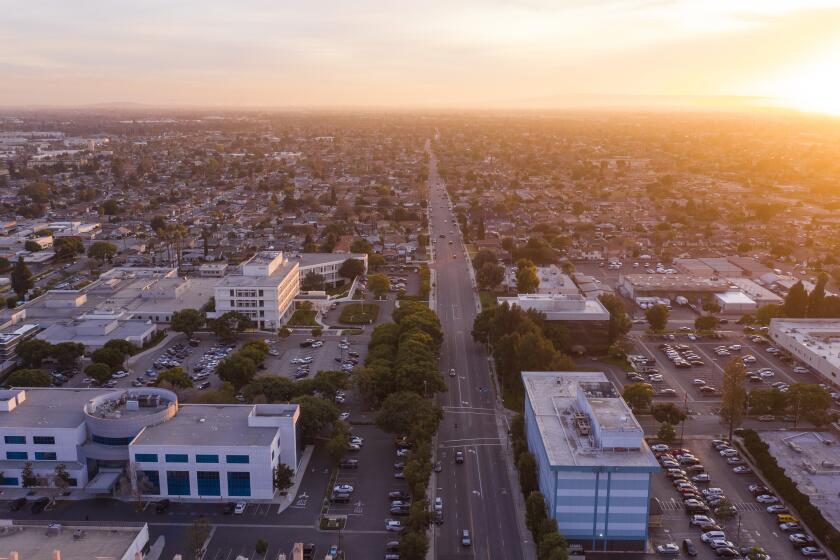Group Argues Future of Big Tujunga Wash : Development: Opinions are strongly divided on the plan to build a private golf club.
- Share via
At a hearing Monday over a plan to build an 18-hole private golf club in Big Tujunga Wash, opinions were sharply split between those who said it would be a boon to the area and those who fear it would destroy a natural treasure.
“I’ve never seen a golf course yet where I could get in touch with my Creator,” complained Anita Jesse, a Sunland resident who disputed the developer’s claims that the course would be environmentally sensitive.
On the other side was Joe Cohen, a Sunland retiree unsympathetic to the fate of the slender-horned spineflower. The spineflower, a plant that lives in the rugged wash and is on the federal endangered species list, would be threatened by construction of the golf club, U.S. Fish and Wildlife Service experts have said.
“If most people saw this plant in their yard, they’d pull it out as a weed,” Cohen said.
The championship golf course is being proposed for a 350-acre site north of Sunland by Cosmo World Inc., a California company wholly owned by Minoru Isutani, a Japanese businessman better known as the recent former owner of the famous Pebble Beach golf courses.
*
Monday’s hearing drew a crowd of about 150, ranging from homeowners and business leaders who support the project to other residents and environmental groups who oppose it, including the Sierra Club and the Santa Monica Mountains Conservancy, a state parks agency.
Steve Timm, a vice president for the development company, said his firm hope to lure the Los Angeles Open golf tournament from its current longstanding home at the Riviera Country Club in Pacific Palisades to the proposed course in Big Tujunga Wash.
But under questioning, Timm said Cosmo World has no commitment from the tournament’s sponsor for such a move.
Timm said his company has spent $10 million to develop the site since 1987 and could complete the course 12 to 18 months after receiving final approval from City Hall.
To build, Cosmo World needs two conditional-use permits from the city and approval of its environmental review.
Monday’s hearing before a Planning Department official was a first step in the public review of the project. The next is an Oct. 8 hearing before the Los Angeles City Planning Commission. A commission action can be appealed to the City Council.
An aide to Councilman Joel Wachs, who represents the area, said Wachs has formed no opinion on the project.
*
The Times earlier this year reported that Mayor Tom Bradley, in an unusual show of interest in a land-use matter, intervened with city planners several times to prod them to expedite the processing of the project’s environmental review. The Times also found that Bradley had received more than $30,000 in campaign contributions from the development team.
Bradley has denied being influenced by the money, saying he interceded because he was genuinely upset with how long it was taking the city to review the project.
At the outset of the hearing, Mark Armbruster, attorney for Cosmo World, had as his first priority dismissing reports that his client had gone broke and would be unable to build a golf course in Big Tujunga Wash even if it had the city permits. “It’s absolutely untrue,” Armbruster said. “We wouldn’t be here if we weren’t getting paid.”
Such speculation has been fueled by news accounts that Cosmo World sold its Pebble Beach properties earlier this year at a $300 million loss and that the company has been financially unable to finish other resort projects.
Armbruster also said there was no danger, as some have claimed, that the city could be left with a “white elephant” if Cosmo World began massive earth-moving and stream channelization work to prepare the wash for the course and then went bankrupt, leaving the project unfinished.
The city, Armbruster said, can require the developer to post a bond to guarantee completion of the work “to allay these concerns.” If Cosmo World were unable to do the job, the city would collect the bond money and use it to finance completion of the project, he said.
The project, Armbruster argued, is a public benefit because it will result in levee improvements in Big Tujunga Wash that will protect nearby homes as well as Cosmo World’s golf course investment from flooding. In 1969, floodwaters knocked down the Foothill Boulevard bridge across the wash and entered homes built in the flood plain.
As for the environment, the project “is the most benign use that could be put on this property except no development at all,” Armbruster said.
Without the project, he said, illegal trash dumping and off-road vehicles will put the spineflower in more danger than it is now. Moreover, Cosmo World will use native plants for landscaping and leave more than 100 acres of the site in a natural state, Cosmo World representatives said.
“People in the golf business are environmentalists,” Timm said. When grass fairways replace the existing alluvial scrub plants and rocky debris in the wash it will help alleviate air pollution by “reoxygenating the air,” he said.
But many environmentalists and local activists rejected his arguments.
“We are losing open space and what remains of our natural areas at an alarming rate,” warned Audubon Society representative Sandy Wohlgemuth. “What excuse does a developer have for converting a thriving ecosystem into a playground for affluent members?”
Sierra Club representative Jesse Moorman testified that the project would eliminate 147 acres of alluvial scrub habitat, a rare and dwindling type of ecosystem that supports not only the spineflower but many other threatened plant and animal species.
Santa Monica Mountains Conservancy official Carolyn Barr said her agency is considering the possibility of buying the wash from the developer to preserve it as the “last remaining wildlife corridor” connecting the Verdugo Mountains on the south to the Angeles National Forest to the north.
But many proponents of the golf course, including Timm and Jim Peterson, a local publicist, contended Monday that Big Tujunga Wash is an “urban trash dump” and an “eyesore” inhabited by transients who sell drugs to teen-agers.
More to Read
Sign up for Essential California
The most important California stories and recommendations in your inbox every morning.
You may occasionally receive promotional content from the Los Angeles Times.













